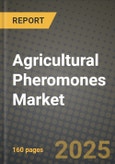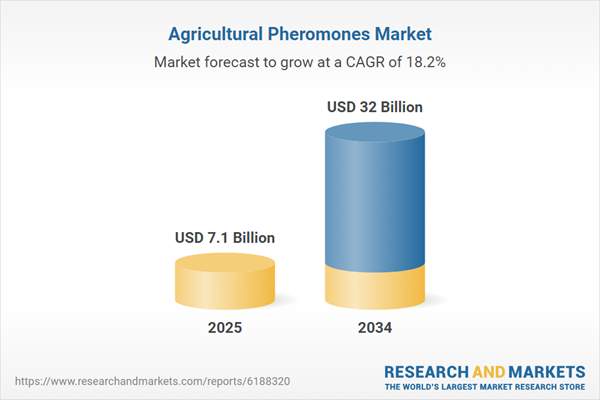The agricultural pheromones market is experiencing rapid growth, driven by the increasing need for sustainable pest control solutions in modern farming. Pheromones, which are naturally occurring chemicals that influence the behavior of pests, are used in agricultural pest management systems to disrupt mating cycles and reduce pest populations. These biopesticides provide an eco-friendly alternative to traditional chemical pesticides, which are associated with environmental concerns and pesticide resistance. The adoption of pheromones in integrated pest management (IPM) programs is gaining popularity as farmers seek to protect crops while minimizing environmental impact. The growing focus on organic farming and sustainable agriculture is also contributing to the market's expansion.
The agricultural pheromones market is witnessing significant advancements in pheromone-based technologies, including the development of more effective and longer-lasting formulations. The integration of AI and IoT in pest monitoring systems is enhancing the precision and efficiency of pheromone applications. The rise in the use of pheromones in greenhouse farming and organic crop production is boosting demand, as these methods help reduce the need for chemical interventions. Additionally, the increasing use of pheromone traps for monitoring pest populations is improving pest control strategies. Governments and agricultural organizations are promoting the adoption of pheromone-based solutions through incentives and regulatory support, further driving the market's growth.
The agricultural pheromones market is expected to benefit from innovations in the development of more targeted, species-specific pheromones that can manage a wider range of pests. The growing interest in precision agriculture and digital pest management will lead to greater integration of pheromone applications with AI and remote sensing technologies. The rising demand for eco-friendly pest control solutions and the continuous development of sustainable farming practices will ensure that pheromones remain a critical tool in modern agriculture. As the agricultural industry focuses on reducing pesticide reliance and improving sustainability, pheromones will play an increasingly vital role in pest management systems.
Key Insights: Agricultural Pheromones Market
- Advancements in Species-Specific Pheromones: New formulations are targeting specific pests, improving the effectiveness of pheromone-based pest control.
- Integration with AI and Digital Pest Management: AI-powered pest monitoring systems are enhancing the precision and efficiency of pheromone applications.
- Rising Adoption of Organic Farming: The increasing use of pheromones in organic farming is driving the demand for chemical-free pest control solutions.
- Growth in Greenhouse Farming: Pheromone-based pest management is becoming more popular in controlled environment agriculture due to its effectiveness and eco-friendliness.
- Government Incentives for Sustainable Pest Control: Policies promoting environmentally friendly pest management solutions are encouraging the adoption of pheromones in agriculture.
- Rising Demand for Sustainable Pest Control: The growing preference for eco-friendly pest management solutions is driving the adoption of pheromones.
- Increase in Organic Farming Practices: As organic farming becomes more popular, the use of pheromones is expanding due to their chemical-free nature.
- Government Regulations on Pesticide Use: Stricter regulations and the push to reduce pesticide use are fueling the demand for alternative pest control solutions like pheromones.
- Advancements in Pest Monitoring Technologies: The integration of digital technologies in pest management is enhancing the precision of pheromone applications.
- High Cost and Availability of Pheromones: The cost of production and availability of pheromone-based products can limit their widespread adoption, especially in smaller farming operations.
Agricultural Pheromones Market Segmentation
By Type
- Sex Pheromones
- Aggregation Pheromones
- Other Types
By Function
- Detection and Monitoring
- Mass Trapping
- Mating Disruption
- Other Functions
By Crop Type
- Field Crops
- Vegetables
- Orchard Crops
- Other Crop Types
By Mode Of Application
- Dispensers
- Traps
- Sprayers
Key Companies Analysed
- BASF SE
- Yara International ASA
- Nutrien Ltd.
- Nouryon BV
- Compass Minerals International
- Helena Chemical Company
- Corteva Agriscience
- Coromandel International Limited
- Haifa Group
- Valagro S.p.A
- Sigma AgriScience LLC
- Aries Agro Limited
- AgroLiquid
- Agrium Inc.
- Dow Chemical Company
- ATP Nutrition Ltd.
- Baicor L.C.
- Stoller USA Inc.
- Akzonobel N.V
- Sumitomo Chemical Co. Ltd.
- Syngenta International AG
- Brandt Consolidated Inc.
- Grow More Inc.
- Western Nutrients Corporation
- The Mosaic Company
- Nufarm Limited
- ICL Group Ltd.
- Chambal Fertilisers and Chemicals Limited
- Sapec Group
- Green Has Italia SPA
Agricultural Pheromones Market Analytics
The report employs rigorous tools, including Porter’s Five Forces, value chain mapping, and scenario-based modeling, to assess supply-demand dynamics. Cross-sector influences from parent, derived, and substitute markets are evaluated to identify risks and opportunities. Trade and pricing analytics provide an up-to-date view of international flows, including leading exporters, importers, and regional price trends.Macroeconomic indicators, policy frameworks such as carbon pricing and energy security strategies, and evolving consumer behavior are considered in forecasting scenarios. Recent deal flows, partnerships, and technology innovations are incorporated to assess their impact on future market performance.
Agricultural Pheromones Market Competitive Intelligence
The competitive landscape is mapped through proprietary frameworks, profiling leading companies with details on business models, product portfolios, financial performance, and strategic initiatives. Key developments such as mergers & acquisitions, technology collaborations, investment inflows, and regional expansions are analyzed for their competitive impact. The report also identifies emerging players and innovative startups contributing to market disruption.Regional insights highlight the most promising investment destinations, regulatory landscapes, and evolving partnerships across energy and industrial corridors.
Countries Covered
- North America - Agricultural Pheromones market data and outlook to 2034
- United States
- Canada
- Mexico
- Europe - Agricultural Pheromones market data and outlook to 2034
- Germany
- United Kingdom
- France
- Italy
- Spain
- BeNeLux
- Russia
- Sweden
- Asia-Pacific - Agricultural Pheromones market data and outlook to 2034
- China
- Japan
- India
- South Korea
- Australia
- Indonesia
- Malaysia
- Vietnam
- Middle East and Africa - Agricultural Pheromones market data and outlook to 2034
- Saudi Arabia
- South Africa
- Iran
- UAE
- Egypt
- South and Central America - Agricultural Pheromones market data and outlook to 2034
- Brazil
- Argentina
- Chile
- Peru
Research Methodology
This study combines primary inputs from industry experts across the Agricultural Pheromones value chain with secondary data from associations, government publications, trade databases, and company disclosures. Proprietary modeling techniques, including data triangulation, statistical correlation, and scenario planning, are applied to deliver reliable market sizing and forecasting.Key Questions Addressed
- What is the current and forecast market size of the Agricultural Pheromones industry at global, regional, and country levels?
- Which types, applications, and technologies present the highest growth potential?
- How are supply chains adapting to geopolitical and economic shocks?
- What role do policy frameworks, trade flows, and sustainability targets play in shaping demand?
- Who are the leading players, and how are their strategies evolving in the face of global uncertainty?
- Which regional “hotspots” and customer segments will outpace the market, and what go-to-market and partnership models best support entry and expansion?
- Where are the most investable opportunities - across technology roadmaps, sustainability-linked innovation, and M&A - and what is the best segment to invest over the next 3-5 years?
Your Key Takeaways from the Agricultural Pheromones Market Report
- Global Agricultural Pheromones market size and growth projections (CAGR), 2024-2034
- Impact of Russia-Ukraine, Israel-Palestine, and Hamas conflicts on Agricultural Pheromones trade, costs, and supply chains
- Agricultural Pheromones market size, share, and outlook across 5 regions and 27 countries, 2023-2034
- Agricultural Pheromones market size, CAGR, and market share of key products, applications, and end-user verticals, 2023-2034
- Short- and long-term Agricultural Pheromones market trends, drivers, restraints, and opportunities
- Porter’s Five Forces analysis, technological developments, and Agricultural Pheromones supply chain analysis
- Agricultural Pheromones trade analysis, Agricultural Pheromones market price analysis, and Agricultural Pheromones supply/demand dynamics
- Profiles of 5 leading companies - overview, key strategies, financials, and products
- Latest Agricultural Pheromones market news and developments
Additional Support
With the purchase of this report, you will receive:- An updated PDF report and an MS Excel data workbook containing all market tables and figures for easy analysis.
- 7-day post-sale analyst support for clarifications and in-scope supplementary data, ensuring the deliverable aligns precisely with your requirements.
- Complimentary report update to incorporate the latest available data and the impact of recent market developments.
This product will be delivered within 1-3 business days.
Table of Contents
Companies Mentioned
- BASF SE
- Yara International ASA
- Nutrien Ltd.
- Nouryon BV
- Compass Minerals International
- Helena Chemical Company
- Corteva Agriscience
- Coromandel International Limited
- Haifa Group
- Valagro S.p.A
- Sigma AgriScience LLC
- Aries Agro Limited
- AgroLiquid
- Agrium Inc.
- Dow Chemical Company
- ATP Nutrition Ltd.
- Baicor L.C.
- Stoller USA Inc.
- Akzonobel N.V
- Sumitomo Chemical Co. Ltd.
- Syngenta International AG
- Brandt Consolidated Inc.
- Grow More Inc.
- Western Nutrients Corporation
- The Mosaic Company
- Nufarm Limited
- ICL Group Ltd.
- Chambal Fertilisers and Chemicals Limited
- Sapec Group
- Green Has Italia SPA
Table Information
| Report Attribute | Details |
|---|---|
| No. of Pages | 160 |
| Published | October 2025 |
| Forecast Period | 2025 - 2034 |
| Estimated Market Value ( USD | $ 7.1 Billion |
| Forecasted Market Value ( USD | $ 32 Billion |
| Compound Annual Growth Rate | 18.2% |
| Regions Covered | Global |
| No. of Companies Mentioned | 30 |









